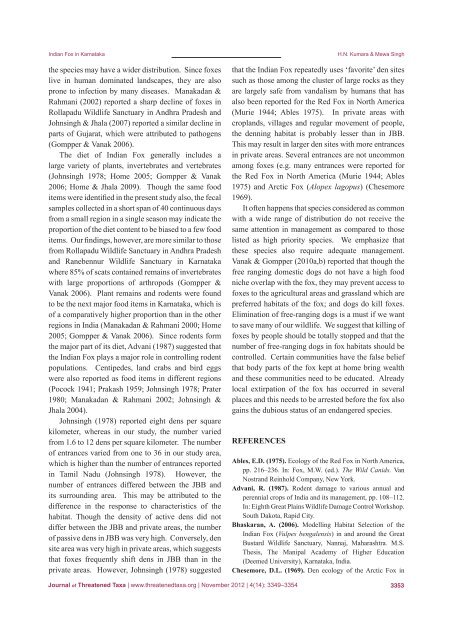View - Journal of Threatened Taxa
View - Journal of Threatened Taxa
View - Journal of Threatened Taxa
Create successful ePaper yourself
Turn your PDF publications into a flip-book with our unique Google optimized e-Paper software.
Indian Fox in Karnatakathe species may have a wider distribution. Since foxeslive in human dominated landscapes, they are alsoprone to infection by many diseases. Manakadan &Rahmani (2002) reported a sharp decline <strong>of</strong> foxes inRollapadu Wildlife Sanctuary in Andhra Pradesh andJohnsingh & Jhala (2007) reported a similar decline inparts <strong>of</strong> Gujarat, which were attributed to pathogens(Gompper & Vanak 2006).The diet <strong>of</strong> Indian Fox generally includes alarge variety <strong>of</strong> plants, invertebrates and vertebrates(Johnsingh 1978; Home 2005; Gompper & Vanak2006; Home & Jhala 2009). Though the same fooditems were identified in the present study also, the fecalsamples collected in a short span <strong>of</strong> 40 continuous daysfrom a small region in a single season may indicate theproportion <strong>of</strong> the diet content to be biased to a few fooditems. Our findings, however, are more similar to thosefrom Rollapadu Wildlife Sanctuary in Andhra Pradeshand Ranebennur Wildlife Sanctuary in Karnatakawhere 85% <strong>of</strong> scats contained remains <strong>of</strong> invertebrateswith large proportions <strong>of</strong> arthropods (Gompper &Vanak 2006). Plant remains and rodents were foundto be the next major food items in Karnataka, which is<strong>of</strong> a comparatively higher proportion than in the otherregions in India (Manakadan & Rahmani 2000; Home2005; Gompper & Vanak 2006). Since rodents formthe major part <strong>of</strong> its diet, Advani (1987) suggested thatthe Indian Fox plays a major role in controlling rodentpopulations. Centipedes, land crabs and bird eggswere also reported as food items in different regions(Pocock 1941; Prakash 1959; Johnsingh 1978; Prater1980; Manakadan & Rahmani 2002; Johnsingh &Jhala 2004).Johnsingh (1978) reported eight dens per squarekilometer, whereas in our study, the number variedfrom 1.6 to 12 dens per square kilometer. The number<strong>of</strong> entrances varied from one to 36 in our study area,which is higher than the number <strong>of</strong> entrances reportedin Tamil Nadu (Johnsingh 1978). However, thenumber <strong>of</strong> entrances differed between the JBB andits surrounding area. This may be attributed to thedifference in the response to characteristics <strong>of</strong> thehabitat. Though the density <strong>of</strong> active dens did notdiffer between the JBB and private areas, the number<strong>of</strong> passive dens in JBB was very high. Conversely, densite area was very high in private areas, which suggeststhat foxes frequently shift dens in JBB than in theprivate areas. However, Johnsingh (1978) suggestedH.N. Kumara & Mewa Singhthat the Indian Fox repeatedly uses ‘favorite’ den sitessuch as those among the cluster <strong>of</strong> large rocks as theyare largely safe from vandalism by humans that hasalso been reported for the Red Fox in North America(Murie 1944; Ables 1975). In private areas withcroplands, villages and regular movement <strong>of</strong> people,the denning habitat is probably lesser than in JBB.This may result in larger den sites with more entrancesin private areas. Several entrances are not uncommonamong foxes (e.g. many entrances were reported forthe Red Fox in North America (Murie 1944; Ables1975) and Arctic Fox (Alopex lagopus) (Chesemore1969).It <strong>of</strong>ten happens that species considered as commonwith a wide range <strong>of</strong> distribution do not receive thesame attention in management as compared to thoselisted as high priority species. We emphasize thatthese species also require adequate management.Vanak & Gompper (2010a,b) reported that though thefree ranging domestic dogs do not have a high foodniche overlap with the fox, they may prevent access t<strong>of</strong>oxes to the agricultural areas and grassland which arepreferred habitats <strong>of</strong> the fox; and dogs do kill foxes.Elimination <strong>of</strong> free-ranging dogs is a must if we wantto save many <strong>of</strong> our wildlife. We suggest that killing <strong>of</strong>foxes by people should be totally stopped and that thenumber <strong>of</strong> free-ranging dogs in fox habitats should becontrolled. Certain communities have the false beliefthat body parts <strong>of</strong> the fox kept at home bring wealthand these communities need to be educated. Alreadylocal extirpation <strong>of</strong> the fox has occurred in severalplaces and this needs to be arrested before the fox alsogains the dubious status <strong>of</strong> an endangered species.ReferencesAbles, E.D. (1975). Ecology <strong>of</strong> the Red Fox in North America,pp. 216–236. In: Fox, M.W. (ed.). The Wild Canids. VanNostrand Reinhold Company, New York.Advani, R. (1987). Rodent damage to various annual andperennial crops <strong>of</strong> India and its management, pp. 108–112.In: Eighth Great Plains Wildlife Damage Control Workshop.South Dakota, Rapid City.Bhaskaran, A. (2006). Modelling Habitat Selection <strong>of</strong> theIndian Fox (Vulpes bengalensis) in and around the GreatBustard Wildlife Sanctuary, Nannaj, Maharashtra. M.S.Thesis, The Manipal Academy <strong>of</strong> Higher Education(Deemed University), Karnataka, India.Chesemore, D.L. (1969). Den ecology <strong>of</strong> the Arctic Fox in<strong>Journal</strong> <strong>of</strong> <strong>Threatened</strong> <strong>Taxa</strong> | www.threatenedtaxa.org | November 2012 | 4(14): 3349–33543353

















